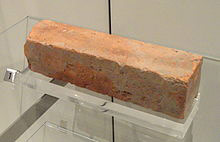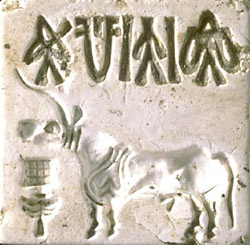
Indus-Sarasvati Civilization:
Harappa 3500–1900 BCE
The ancient city of Harappa, situated on a tributary to the Indus River in Pakistan, grew into a bustling settlement based on farming and trade. Damage under British colonial rule and looting by local people likely set back our knowledge of this civilization.
In 1856, General Alexander Cunningham, later director general of the archaeological survey of northern India, visited Harappa where the British engineers John and William Brunton were laying the East Indian Railway Company line connecting the cities of Karachi and Lahore. John wrote: “I was much exercised in my mind how we were to get ballast for the line of the railway.” They were told of an ancient ruined city near the lines, called Brahminabad. Visiting the city, he found it full of hard well-burnt bricks, and, “convinced that there was a grand quarry for the ballast I wanted,” the city of Brahminabad was reduced to ballast. A few months later, further north, John’s brother William Brunton’s “section of the line ran near another ruined city, bricks from which had already been used by villagers in the nearby village of Harappa at the same site. These bricks now provided ballast along 93 miles (150 km) of the railroad track running from Karachi to Lahore.” writes Robert Davreau in The World’s Last Mysteries.
Damage under Colonial rule and looting by local people likely set back our knowledge of Harappa, yet the trajectory of the Indus-Sarasvati Civilization can still be traced in the layers of its rubble. By 3500 to 3300 BCE settlement at Harappa, situated on a tributary to the Indus River in Pakistan, had begun. Known as the Ravi Phase after the river of its name, this phase saw small communities of hunters, fishermen and farmers.

By approximately 3000 BCE there appears to have been an increase in the food surpluses produced by these early farming communities, which led to trade expansion and to the establishment of outposts.
Harappa grew into a bustling urban center of over 20,000 people. What prompted such growth? The original impetus may have been a gradual shift from hunting to farming and herding, subsequently combined with unusually favorable changes in climate, creating a window of opportunity.

The aforementioned decline in monsoon rains that stimulated migration from the now too-arid region of Baluchistan and regions in the West caused a reduced amount of flooding in the Indus Sarasvati valleys. The Himalayan-fed Indus became less wild, and the Sarasvati flooding became predictable, stimulating prolific farming along its banks and immigration to the region. Conditions became ideal: irrigation was manageable and stable, stimulating intensive agriculture, for over a thousand years. Food abundance—a granary at Harappa has been excavated that measured 169 ft x 135 ft—led to a degree of specialization, which created a feedback loop of even greater surpluses. It is worth noting that, unlike other ancient civilizations of Egypt or Mesopotamia, all this seems to have been accomplished without any form of forced labor or slavery.

Pottery of the early period was handmade, not wheel made, with fairly plain decorations of leaves, geometric shapes and simple animals.

Excavations reveal a clear continuity of skills and technology between the earlier pastoral settlements like Mehrgarh and the later urban settlements like Harappa and Mohenjo-Daro further down the Indus river.
Both the Ravi and Hakra Ware found at Harappa show similarities with earlier styles found in Baluchistan, which is not surprising. What really distinguishes this new urban phase is increased specialization and productivity, creating an economic surplus. It’s very likely that at least some people for the first time experienced what it was like to have disposable income and the leisure to use it.
The Kot-Diji, or second phase, at Harappa (2800 to 2600 BCE) shows an increasing complexity and sophistication in crafts and pottery. Most pottery of the period was wheel made, not handmade. There is evidence of the manufacture of faience (glazed) beads in a variety of shapes, all of a unique high quality. Fired at extremely high temperatures, these were not manufactured in either Egypt or Mesopotamia, which most likely led to demand from those far-off regions for Indus-Sarasvati beadwork. Decorated terracota bangles and gold sequins have also been found from this period.



2800–2600 BCE marks the beginning of what is known as the third Mature or Integration phase: the true urbanization of Harappa. Streets are now laid out along the cardinal directions (north to south and east to west). Houses are laid out in an organized fashion along the streets and built from bricks of a standard size, following the dimensions 4:2:1. Two huge surrounding walls were built around two separate raised mounds upon which the settlement is located. Most likely the walls were primarily built to guard against flooding, and of course for protection.

The making of various types of distinctive seals show increased sophistication with the use of soapstone and steatite carved into squares and inscribed with script, shapes and figures. Pottery and tools of copper and stone were standardized. These and standardized weights suggest a system of tightly controlled trade. At this time, terracotta figurines depicting people and animals were common and almost all pottery is now wheel made, featuring red slip with black painted motifs.


The types and varieties of beads, copper and bronze objects increased in the period, and since we know that cotton and silk were cultivated, we can hypothesize that clothing and furnishings also became more diverse and were perhaps sold by specialist dressmakers.

As already mentioned, by 2600 BCE many of the earlier settlements in the west appear to have been hastily abandoned as their inhabitants migrated eastwards. In some regions like Cholistan, only about 10% remained continuously occupied. Harappa continued to expand and other major settlements like Mohenjo-Daro were established. Platforms for buildings can be found throughout the region from this period. Presumably these clay and mud brick platforms served the same function that they are believed to have served at well-excavated Mohenjo-Daro and Harappa: to place both living quarters and storage out of reach of the constant threat of flooding. At Kalibangan, another important Indus-Sarasvati site, we find a number of separate platforms from this period, one of which held what appear to be seven fire altars, or “ritual hearths,” which have also been noted in Lothal and Amri. Other scholars suggest that these could have been fire pits used for cooking or baking.
External Stories and Videos

Aryan Migration: Everything You Need to Know About the New Study on Indian Genetics
Rohan Venkataramakrishnan, Scroll.in
The study says some sort of migration did indeed take place into India and that the Indus Valley civilization is key to all South Asian populations.

The ‘Earliest writing’ found
Dr. David Whitehouse, BBC News
The first known examples of writing may have been unearthed at an archaeological dig in Pakistan.

Harappa.com
Explore the ancient Indus Valley civilization through slideshows, essays and articles from leading scholars from India, Pakistan, US, and Europe.
